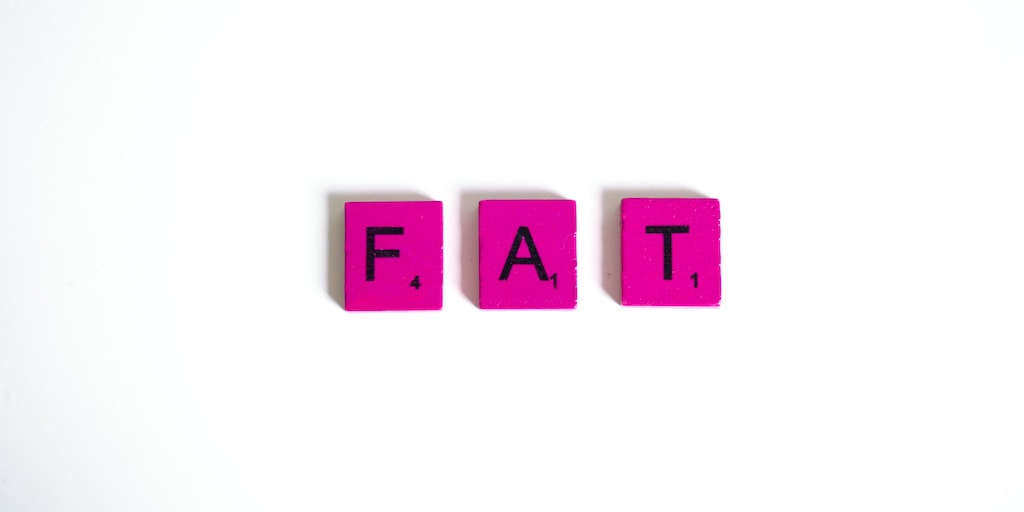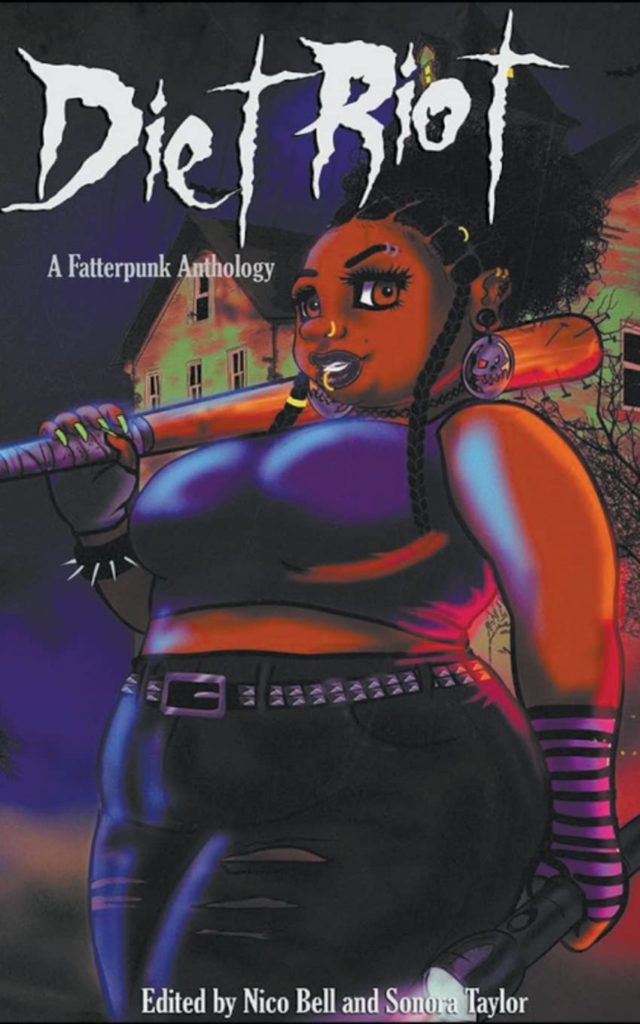By Nico Bell and Sonora Taylor
Fat bodies are finally having their moment in the horror spotlight. While larger bodies are often demonized on the big screen or between the pages of our favorite scary books, the past few years have seen a cultural shift towards empowering more horror creatives to include fat positive representation in their work. Authors are setting aside the large and grotesque villain stereotype in exchange for well-rounded, fully-developed fat protagonists simply living their lives in horror stories.
As fat women, we wanted to be a part of this growing movement. So, in September of 2021, we put out an open submission call to the horror community asking for stories with empowering fat representation. What materialized was Diet Riot: A Fatterpunk Anthology, a collection of twelve fat-positive horror stories that bring thrills, chills, and scares aplenty–and none of these stories use fatness as a punchline. The anthology is available through all online retailers starting June 21, 2022–and in our humble opinion, it’s coming none too soon.
blank text
blank text
What is fat positivity?
It was important for us to properly define and represent fat positivity. The term is a subcategory of body positivity, which is an activist and allyship movement that has been challenging cultural norms since the 1960s. Body positivity encompasses all marginalized bodies, from Black and Brown bodies to queer and gender non-conforming bodies, disabled bodies, bodies with limb differences, bodies with scars, and, yes, fat bodies. The idea of the original movement was to work towards equality, respect, and representation for everyone, no matter what their bodies look like.
Fat positivity has become more prominent as activists and allies step into the mainstream spotlight. Whether it’s fashion model Tess Holliday publicly embracing her curves, Hijabi social media influencer Leah Vernon proclaiming her truth as a fat Muslim Black woman, or author Megan Jayne Crabbe warning against the toxicity of diet culture, larger bodies are claiming their spots in a culture designed to squeeze them out. The message is simple: All bodies deserve respect, dignity, and the right to exist without discrimination and prejudice.
But in a society where the term fat is synonymous with negativity, is that even possible?
It’s time to retire fatphobia in horror.
The way we see our bodies is often a reflection of the values society projects on them. We’ve frequently been asked about our favorite examples of fat positivity in horror fiction–and which representations we like the least. Sadly, there are far more contenders in the latter category. Fatphobia seems to lurk around every corner in horror fiction, waiting in the shadows to jump out and ruin an otherwise pleasant engagement with a story (yes, we said pleasant–we are horror fans, after all).
Take the iconic horror movie Silence of the Lambs. James “Buffalo Bill” Gumb targets larger women with the intention of removing their skin to make a woman suit. Catherine, his latest victim, is a size fourteen, which is arguably not fat, but instead, an average size for many women. Whether or not that’s considered fat, though, the message is clearly received: Catherine wouldn’t have been targeted if she were skinny. Thin bodies are safe. Thin bodies are respected. Thin bodies survive.
A more recent example of fatphobia in horror is The Green Inferno, directed by Eli Roth. The movie contains a plus-sized man who ends up being killed off first because he can provide a cannibal society with the most meat. Before this, he is portrayed as the “fat, lovable friend,” a common stereotype in all fiction. There is a moment in the film where it’s suggested he has a crush on the female protagonist (a thin woman), and his desire is mocked by a slender male character who says, “You’re such a fat guy in love… There’s nothing sadder than that.” The real sadness is that this dialogue made it into the movie. Treatment of fat characters in such a way only increases discrimination, prejudice, and bullying of people with large bodies in the real world.
Don’t even get us started on the fat victim in Seven.
Even when it’s not portrayed as worthy of mockery, disgust, or outright hatred, fatness is often equated with being pathetic, pitiful, or sad. Neil Gaiman’s The Sandman is a wonderful series, but it’s troublesome that of all the siblings who comprise The Endless, that Despair is the only one who’s fat. Despair is not villainized, but by using her size as a defining characteristic, the story reinforces the idea that being fat means there’s something inherently wrong with you. And by equating the human emotion of despair with the largest Endless sibling, it reinforces the idea that fatness is sad, miserable, and pitiable. After all, why would a fat person ever be happy?
But it’s not all hopeless!
While it was depressingly easy to think of examples of negative portrayals of fatness, there are a growing number of positive examples in fiction too. Other genres, like romance, are beginning to break down barriers and include fat characters. Dietland by Sarai Walker introduces the audience to Plum Kettle, a fat woman who craves a thin body, only to discover it’s not her that needs to change, but rather, society. Spoiler Alert by Olivia Dade is a romance featuring a fat heroine who loves herself and also finds love with a partner, going against the destructive and inaccurate cultural narrative that in order to find romance, a body must shrink. Faith: Taking Flight by Julie Murphy is a YA novel featuring a fat superhero who can fly, giving body positive representation to readers of all ages.
Fat positivity is also slowly making its way into horror. One great example is in Gretchen Felker-Martin’s excellent post-apocalyptic novel, Manhunt. Indi, one of the main characters, is fat. But while she struggles with her size, the struggles come from the reality of a world that refuses to accommodate fat bodies, rather than presenting her issues as hers alone. Indi is also far more than her weight. She is an object of affection and attraction for another of the main characters, she’s a doctor actively recruited and valued for her expertise, and she’s a hero who springs into action when needed. Another character, Feather, is a fat sex worker who is given dignity, depth, and beautiful characterization–things that both fat people and sex workers tend not to receive very much of in horror.
We have the building blocks for more fat positivity in horror. Now we just need more of it!
How to write fat-positive characters
By now, hopefully you’re asking: how do I write more fat-positive characters?
The first step is, of course, to write them. Don’t dodge the issue! One of the reasons we may default to thinking of the inclusion of a fat character as negative is because, in the majority of the media we consume, it is negative. But when we have more and more varied positive or neutral fat characters, that perception changes. We as readers and viewers have a bigger pool of portrayals of fatness to choose from.
Now that your fat character exists (yay!), it’s time to consider the context in which you place them. We need fat protagonists where their fatness isn’t their most defining character trait–too often, fat characters are forced to go through trauma about their bodies and then achieve some form of self-discovery (or worse, dieting). A fat character can and should be able to enjoy everything a thin character does. It will be through their own unique lens, but that uniqueness shouldn’t come at the expense of the character’s dignity, nor should it be used as code to indicate this character is bad, pathetic, or repulsive.
Don’t get us wrong: we’re all about fat villains and anti-heroes too. But trust that your fat serial killer can be a bad person for reasons that have nothing to do with their size (like, for instance, the fact that they murder people). Use their size as a characteristic, not as a code.
For example, Diet Riot: A Fatterpunk Anthology includes a wide variety of fat characters–roller derby athletes, sassy teenagers, bakers, trash collectors, and fat people in love. In some stories, the protagonists find self-love in their larger bodies, while other stories simply feature a fat person existing, enjoying life, only to be plopped into the middle of an unrelated nightmare. Either approach helps push a positive narrative towards a group of individuals who have been the punchline for too many jokes, the victims of too much bullying, and the recipients of prejudice and discrimination for decades.
Say the word “fat.“
Perhaps the most important aspect of overcoming fatphobia in horror is to utter that little three letter word. We promise, it’s okay. The word “fat” can hold no negative power if you choose to embrace it. We understand this is hard, because as a culture, we’ve been so conditioned to interpret “fat” as an insult-in fact, even when fat people refer to ourselves as fat, we’re faced with smaller people telling us not to talk about ourselves that way.
It can be difficult to describe a character’s larger body without sounding negative by default, and writers may worry that when they say a character is fat, large, full-figured, chubby, curvy, etc., that they’re insulting that character and creating a negative depiction. But that’s not true! The use of the word “fat” can be empowering. It’s all about context–treat “fat” as a neutral descriptor, just as you would words like “tall” or “brunette.” (Avoid using the words “obese” and “overweight,” however–many fat people consider those to be harmful, derogatory remnants of a medical system that pathologizes body size in dangerous ways.)
So, let’s do it. Let’s reclaim the “f” word and bring more positive fat representation in horror. It’s an expansive genre–there’s room here for everybody and every body.





One thought on “Reclaiming the “F” Word: Why We Need Fat Positivity in Horror”